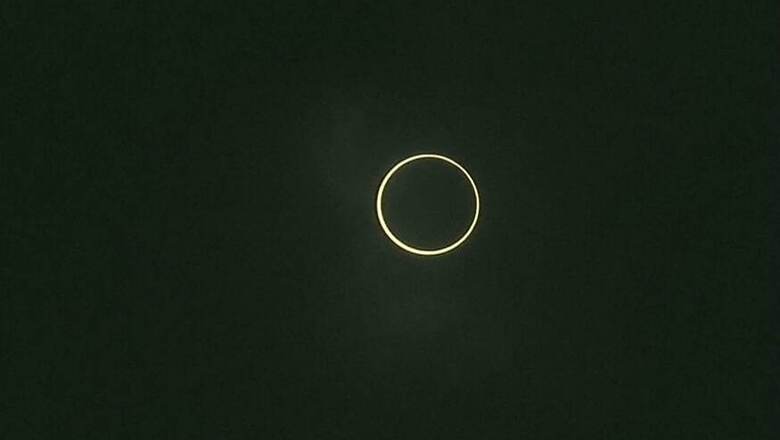
views
Solar eclipse 2019: On December 26, the partial eclipse will begin at 8.04 am when the moon 'touches' the sun's edge, and at 9.24 am the annular phase will start and the full eclipse would be visible, a report stated. Partial phases of the solar eclipse will be visible from all over the country in varying magnitude depending upon the geographical position.
What is solar eclipse?
A solar eclipse occurs when the Moon passes between Earth and the Sun, thereby totally or partly obscuring the Sun for a viewer on Earth. An annular solar eclipse takes place when the moon's apparent diameter is smaller than that of the Sun's and blocks most of the Sun's light. This causes the Sun to look like a ring (annulus) of fire. According to Travel and Leisure, the "ring of fire" eclipse will last for just under four minutes.
Where Will it be Seen?
Thursday's eclipse will be visible in Saudi Arabia, Qatar, United Arab Emirates, Oman, India, Sri Lanka, Malaysia, Indonesia, Singapore, Northern Mariana Islands, and Guam. Population centers in the path of the annularity include Udhagamandalam, Kozhikode, Coimbatore, Jaffna, Trincomalee, Singapore, Singkawang and Guam.
Partial phases of the solar eclipse will be visible from all over the country in varying magnitude depending upon the geographical position. The annularity phases will be seen within a narrow path grazing the southern Indian peninsula through Karnataka, Kerala and Tamil Nadu before crossing the Bay of Bengal for northern Sri Lanka.
The people of the southern part of the country will be fortunate to see a greater part of the partial solar eclipse because of the geometry of the eclipse path. But every Indian will get an opportunity to see at least a partial eclipse. In India the maximum duration of the annularity phases will be just over 3 minutes, Debiprosad Duari, the Director, Research and Academic of MP Birla Institute of Fundamental Research, MP Birla Planetarium, said.
Advisory for Viewing the Eclipse
One should not look at the Sun directly for even a little period without proper protection. Even when 99 per cent of the surface of the Sun is covered by the moon during partial eclipse, the remaining light is still intense enough to damage the eye, Duari said.
Proper solar filters with certified appropriate optical density against radiation which are safe to the eyes should be used in front optical devices and the naked eye, he said. Aluminised mylar films of approved thickness and transmittivity coated with black polymer are the safest for use in solar goggles that one generally uses for eclipse viewing, he said.
Welders glass number 14 is a safe material as solar filter for direct viewing of the solar disc, the researcher said. According to him, the best method to view the solar eclipse will be to use a pinhole camera or a telescopic projection on a suitable surface.
Use of unsafe filters like smoked glass, polarising filter, sun glasses, photographic neutral density filters, colour films are not advised to view the solar phenomenon, he said.
(With PTI inputs)




















Comments
0 comment